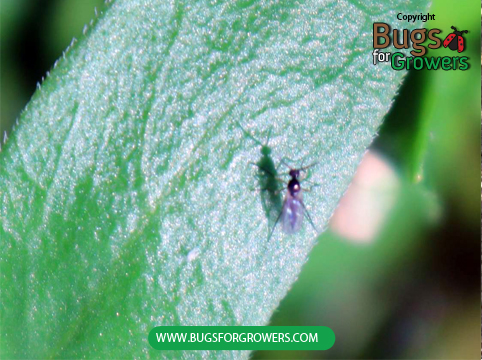Organic control of fungus gnats
Predatory mites, Stratiolaelaps scimitus (Hypoaspis miles) are currently used for the organic control of fungus gnats (Bradysia spp.).
What are fungus gnats?
Fungus gnat (Bradysia spp.) adults are brown to black colored small insects (Photo 1) that are not harmful to plants but their larvae are colorless and cause serious damage to many plant species that are generally grown in the closed structures like greenhouses and homes.
Photo 1. An adult of fungus gnat
Damage caused by fungus gnats
Fungus gnats larvae cause both direct and indirect damages to their host plants but their adults cause only indirect damage.
Direct damage by fungus gnat larvae
Larvae of fungus gnats cause direct feeding damage by chewing, stripping and tunneling through the roots and stems of their host plants. Heavily infested plants generally look sick, discolored and may die prematurely.
Indirect damage by fungus gnat larvae
While feeding on the roots and stems, the larvae of fungus gnats cause indirect damage by transmitting disease causing fungal pathogens like Fusarium, Phoma, Pythium and Verticillium to their host plants. These pathogens cause different disease to host plants and eventully kill these infected plants.
Indirect damage caused by fungus gnat adults
Adults of fungus gnats are harmless to plants but nuisance to people. In addition, these adults disseminate spores of many disease causing fungal pathogens from plant to plant when they migrate in through the home or greenhouse.
Predatory mite, Stratiolaelaps scimitus for the organic control of fungus gnats
What are Stratiolaelaps scimitus?
Stratiolaelaps scimitus (Hypoaspis miles) are predatory mites that are currently used as biological control agent to control fungus gnats that are one of the most eonomically important insect pests of home and greenhouse grown potted plants.
Adults: Adults of Stratiolaelaps scimitus are brown to tan in color and about 0.8- 1.0 mm in size.
Eggs: Eggs of Stratiolaelaps scimitus are oval shaped and colorless.
Larvae: Newly hatched mites are called as larvae. These larvae are brown to black in color and they have with six legs.
Nymphs: When larvae of mites pass through successive stages like developmental protonymphal and deutonymphal, they are called nymphs. These immature nymphal stages look like their parents.
Life cycle: Stratiolaelaps scimitus mites generally complete their egg to egg life cycle at optimum temperature between 15-25°C (59-77°F) within 15 days.
Why Stratiolaelaps scimitus mites are used for the organic control of fungus gnats?
Because when both the adult and nymphal stages of Stratiolaelaps scimitus mites are released in the pots containing fungus gnat infested plants, these mites will find and feed on the eggs, larvae and pupae of fungus gnats that in turn will reduce population of fungus gnats.
How Stratiolaelaps scimitus mites will kill fungus gnats?
After application of Stratiolaelaps scimitus mites in the pots containing fungus gnat infested plants, they immediately start looking for fungus gnat eggs, larvae and pupae that are present in the potting media/ soil. Once these mites come in contact with eggs, larvae and pupae, they will begin munching on all of these stages. These mite do not feed on the adults of fungus gnats.
While feeding, these predatory mites can develop and reproduce rapidly and keep population of fungus gnats under control.
Under favorable environmental conditions and if there is enough food around, these mite can recycle continuously (so you do not need to apply again and again) and help to keep the pest population under economic threshold level
When and how Stratiolaelaps scimitus mites should be released?
Follow steps given below:
It is recommended that the predatory Stratiolaelaps scimitus mites should be released immediately after their arrival.
But if for some reason, Stratiolaelaps scimitus mites can not be applied soon after their arrival, store them in the same bottles at between 10 and 20°C (50 and 60°F) only for a couple of days.
As Stratiolaelaps scimitus mites are supplied with food source but if they run out of this food, they will start killing each other.
In addition make sure that bottles are stored on their side and filter paper up so that these mites get more surface area for their movement and avoid crowding..
Stratiolaelaps scimitus mites are supplied as mixed stages in the carrier so that they can be evenly and easily released on to the potting media, soil, dirt and gravel floors, on weeds and ground covers around greenhouses or any other potential place where fungus gnats are continuously developing through different stages like eggs, larvae, pupae and adults.
To release these mites directly from bottles, first slowly rotate the bottle to mix the mites evenly in the carrier. Then open the bottle, remove filter paper and then close bottle with perforated lid.
Then tap the mites out of the bottle on tro the fungus gnat infested potting media and soil surfaces.
Release a high numbers of mites where high populations of fungus gnats are present.
How many Stratiolaelaps scimitus mites should be released?
For effective control of fungus gnats, it is recommended to follow schedule given below.
Release 5-10 predatory Stratiolaelaps scimitus mites/square feet (0.1 sq. meter) area bi-weekly, 2-3 times.
Release 25,000 to 50,000 predatory Stratiolaelaps scimitus mites/acre, bi-weekly, 2-3 times.
